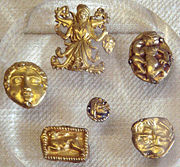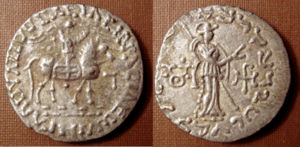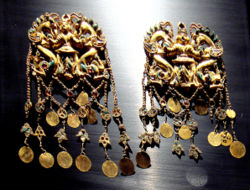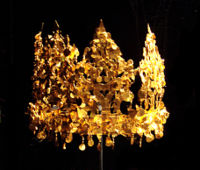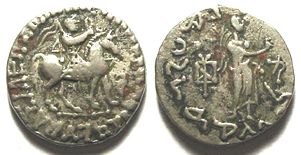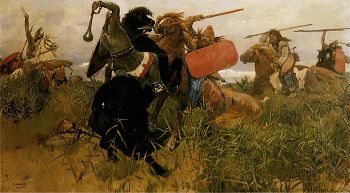سكوذيون
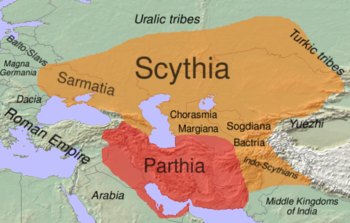 الانتشار التقريبي للغات الإيرانية الشرقية في القرن الأول ق.م. مبين باللون البرتقالي. | |
| التعداد الإجمالي | |
|---|---|
| (غير معروف) | |
| المناطق ذات التواجد المعتبر | |
| شرق اوروبا وسط آسيا شمال الهند | |
| اللغات | |
| لغة سكوذية | |
| الديانة | |
| Animism | |
| الجماعات العرقية ذات الصلة | |
سكوذيون (/'sɪθɪən/, وأيضاً /'sɪðɪən/) أو Scyths (/'sɪθs/[1]; من اليونانية: Σκύθης) هم عشائر حربية تتألف من خليط من المغول والأوربيين، جبابرة متوحّشون ملتحون، يقيمون في عربات ، ويبقون نسائهم في عزلة شديدة، ويركبون الخيل البرية عارية، يحاربون ليعيشوا ، ويعيشون ليحاربوا ويشربون دماء أعاديهم، ويتخذون جلود رؤوس هؤلاء الأعداء قطائل لهم. أضعفوا أشور بغاراتهم الدائمة عليها، واجتاحوا غرب آسيا (حوالي عام 630- 610 ق.م) وأخذوا يدمرون في طريقهم كل شيء ويقتلون كل إنسان، وتقدموا إلى مدن دلتا النيل نفسها، ثم فشا فيهم وباء غريب مجهول قضى على عدد كبير منهم، وغلبهم آخر الأمر الميديون، وردوهم على أعقابهم إلى مساكنهم في الشمال. وإنا لنلمح في هذه القصة ومضة أخرى من المأساة التي تتكرر على الدوام في جميع العصور، وهي ما تفعله القبائل الهمجية الرابضة وراء الأمم القديمة جميعها والمحيطة بها.
هم شعب متنقل ينحدر من أصول إيرانية هاجر من وسط آسيا إلى جنوبي روسيا في القرنين الثامن والسابع قبل الميلاد، وتمركز فيما تعرف اليوم بشبه جزيرة القرم (اوكرانيا حالياً). تمكن السكوذيون من تأسيس إمبراطورية غنية وقوية استمرت لقرون عديدة قبل أن يخضعوا للسارماتيين بين القرنين الرابع قبل الميلاد حتى القرن الثاني الميلادي.
معظم ما نعرفه اليوم عن تاريخ السكوذيين يأتي من الروايات التي دونها المؤرخ اليوناني القديم هيرودوتس، والذي كان قد زار بلادهم. وقد نشرت تلك السجلات بعد دراستها من قبل علماء الأنتروبولوجيا (علم الإنسان) الروس. كما كتب عنهم أيضاً المؤرخ اليهودي فلافيوس يوسيفوس ووصفهم بأنهم شعب ماجوج.[2]
كان السكوذيين يثيرون إعجاب وخوف جيرانهم لخفة حركتهم ولبسالتهم في الحروب والمعارك، خصوصاً لمهارتهم بالفروسية حيث كانوا من أوائل الشعوب الذين تفننوا بركوب الخيل.
التاريخ والتنقيب عن الآثار
جلبت الهجرة السكوذيين من آسيا إلى مقاطعات الكيميريين والذين كانوا يسيطرون بشكل تقليدي على القوقاز وعلى شمال البحر الأسود، وفي حرب استمرت ثلاثون عاماً تمكن السكوذيين من تدمير الكيميريين مؤسسين إمبراطوريتهم التي امتدت من غرب الإمبراطورية الفارسية مروراً بسورية و فلسطين حتى حدود مصر. فقام الميديون حكام إيران آنذاك بمهاجمتهم وطردهم من أناطوليا، لتتحدد أخيراً أرض السكوذيين من بعد الحدود الفارسية حتى منطقة الكوبان على البحر الأسود جنوبي روسيا.
الأصول وما قبل التاريخ (إلى 700 ق.م.)
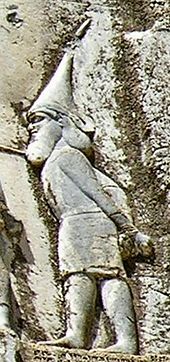
يصنف الباحثون عموماً اللغة السكوذية كعضو في مجموعة اللغات الإيرانية الشرقية, والسكوذيين أنفسهم كفرع من الشعوب الإيرانية القديمة التي انتشرت إلى مناطق السهوب ستيپس steppe إلى الشمال من إيران الكبرى منذ عام 1000 ق.م.[3] [4]
كتاب التواريخ لهيرودوتس يعطي أهم مصدر مكتوب عن السكوذيين القدامى. فحسب سوليمرسكي [5] , فإن هيرودوت يعطي صورة صحيحة، بصفة عامة، إلا أنه لم يعرف الكثير عن الجزء الشرقي من سكوذيا.
The Scythians first appeared in the historical record in the beginning of the first millennium BCE.
[6]
. إلا أن هيرودوت (IV. 11)
[7]
يورد رواية أخرى تقول:
The nomadic tribes of Scythians who lived in Asia were hard-pressed by the Massagetae tribes, were forced across the Araxes into Cimmeria. There is also another different story, now to be related, in which I am more inclined to put faith than in any other. It is that the wandering Scythians once dwelt in Asia, and there warred with the Massagetae, but with ill success; they therefore quit their homes, crossed the Araxes, and entered the land of Cimmeria.
الفترة الكلاسيكية (600 ق.م. إلى 300 م)
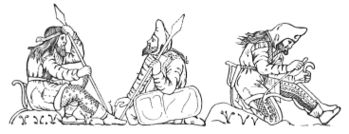
كانت قوة جيوش السكوذيين كافيةً تماماً لصد غزو جحافل الملك الفارسي داريوس الأول حوالي عام 513 قبل الميلاد.
في عام 339 قبل الميلاد قتل ملك السكوذيين آتياس عن عمر يناهز التسعين عاماً في معركة مع الملك المقدوني فيليب الثاني مما أوعز ببدء عصر الانحطاط. ودمرت الإمبراطورية السكوذية بشكل نهائي في القرن الثاني الميلادي، وكان بالاكوس هو آخر ملوك السكوذيين.
الهندو-سكوذيون
 مقالة مفصلة: هندو-سكوذيون
مقالة مفصلة: هندو-سكوذيون
علم الآثار
الكـُرگان Kurgans
 مقالة مفصلة: كـُرگان
مقالة مفصلة: كـُرگان
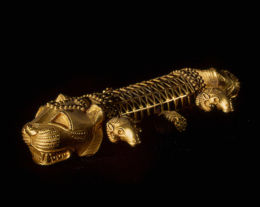
حضارة پازيريك Pazyryk
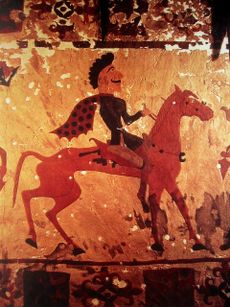
كنز تيليا تـِپي Tillia tepe
التأثير السكوذي
الصين
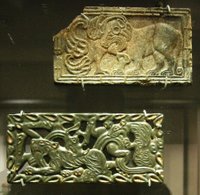

الفن
 مقالة مفصلة: الفن السكوذي
مقالة مفصلة: الفن السكوذي
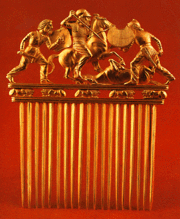
تأريخ
هيرودوت
المصادر الهندية
السكوذيون بعد الكلاسيكيين
المصادر
ديورانت, ول; ديورانت, أرييل. قصة الحضارة. ترجمة بقيادة زكي نجيب محمود.
- ^ ولكن لاحظ Scytho- /'saɪθəʊ/ عند اتخدامها كسابقة (OED)
- ^ أرام. "السكيثيين". ويكيبيديا العربية.
- ^
Oswald Szemerényi, "Four old Iranian ethnic names: Scythian - Skudra - Sogdian - Saka" (Sitzungsberichte der Österreichischen Akademie der Wissenschaften 371), Vienna, 1980 = Scripta minora, vol. 4, pp. 2051-2093. [1]
- ^ Grousset, Rene. "The empire of the Steppes", Rutgers University Press, 1989, pg 19
- ^ Sulimirski, T. "The Scyths," in Cambridge History of Iran, vol. 2: 149-99, http://www.azargoshnasp.net/history/Scythians/scyth_main.htm
- ^ Oswald Szemerényi, "Four old Iranian ethnic names: Scythian - Skudra - Sogdian - Saka" (Sitzungsberichte der Österreichischen Akademie der Wissenschaften 371), pg 5-6, Vienna, 1980 = Scripta minora, vol. 4, pp. 2051-2093. http://www.azargoshnasp.net/history/Scythians/scyth_main.htm
- ^ Oswald Szemerényi, "Four old Iranian ethnic names: Scythian - Skudra - Sogdian - Saka" (Sitzungsberichte der Österreichischen Akademie der Wissenschaften 371), pg 5-6, Vienna, 1980 = Scripta minora, vol. 4, pp. 2051-2093. http://www.azargoshnasp.net/history/Scythians/scyth_main.htm
قراءات اضافية
- Alekseev, A. Yu. et al., "Chronology of Eurasian Scythian Antiquities Born by New Archaeological and 14C Data". Radiocarbon, Vol .43, No 2B, 2001, p 1085-1107.
- Davis-Kimball, Jeannine. 2002. Warrior Women: An Archaeologist's Search for History's Hidden Heroines. Warner Books, New York. 1st Trade printing, 2003. ISBN 0-446-67983-6 (pbk).
- Gamkrelidze and Ivanov (1984). Indo-European and the Indo-Europeans: A Reconstruction and Historical Typological Analysis of a Proto-Language and Proto-Culture (Parts I and II). Tbilisi State University.
- Harmatta, J., "Studies in the History and Language of the Sarmatians", Acta Universitatis de Attila József Nominatae. Acta antique et archaeologica Tomus XIII. Szeged 1970 [3]
- Lebedynsky, I. (2001). "Les Scythes : la civilisation nomade des steppes VIIe - III siècle av. J.-C." / Errance, Paris.
- Lebedynsky Iaroslav (2006) "Les Saces", Editions Errance, ISBN 2877723372
- Mallory, J.P. (1989). In Search of the Indo-Europeans: Language Archeology and Myth. Thames and Hudson. Chapter 2; and pages 51-53 for a quick reference.
- Newark, T. (1985). The Barbarians: Warriors and wars of the Dark Ages. Blandford: New York. See pages 65, 85, 87, 119-139.
- Renfrew, C. (1988). Archeology and Language: The Puzzle of Indo-European origins. Cambridge University Press.
- Rolle, Renate, The world of the Scythians, London and New York (1989).
- Rjabchikov, S. V., The Scythians, Sarmatians, Meotians and Slavs: Sign System, Mythology, Folklore. Rostov-on-Don, 2004 (in Russian)
- Rybakov, Boris. Paganism of Ancient Rus. Nauka, Moscow, 1987 (in Russian)
- Sulimirski, T. "The Scyths", in Cambridge History of Iran, vol. 2: 149-99 [4]
- Szemerényi, O., "Four Old Iranian Ethnic Names: SCYTHIAN - SKUDRA - SOGDIAN - SAKA", Vienna (1980) [5]
- Torday, Laszlo (1998). Mounted Archers: The Beginnings of Central Asian History. Durham Academic Press. ISBN 1-900838-03-6.
- Yatsenko, S. A., "Tamgas of Iranolingual antique and Early Middle Ages people". Russian Academy of Science, Moscow Press "Eastern Literature", 2001 (in Russian)
وصلات خارجية
- "A chronology of the Scythian antiquities of Eurasia based on new archaeological and C-14 data", Alekseev, A.Y. et al A detailed scholarly article on pre-Scythian, early Scythian and classical Scythian archaeological sites and their dating, by the Hermitage Museum's director of archaeology and others.
- "Some problems in the study of the chronology of the ancient nomadic cultures in Eurasia (9th - 3rd centuries BC)", Alekseev, A.Y. et al More of the same.
- "Scythian Gold From Siberia Said to Predate the Greeks" A journalist's article on the Arzhan finds, quoting Hermitage experts
- A Scythian warrior found at a height of 2600 metres in the Altay Mountains in an intact burial mound (August 25, 2006)
- "Coins of Barbarous Tribes of the Northern Black Sea Region"
- Rjabchikov, Sergei V. "The Slavonic Antiquity: Scythians, Sarmatians, Meotians and Slavs" A collection of articles on deciphering of the Scythian/Sarmatian language and script.
- Rjabchikov, S.V., 2005. On Scythian, Sarmatian and Meotian Records about Thunderstorm. AnthroGlobe Journal, 2005
- Rjabchikov, S.V., 2001. The Scythian and Sarmatian Sources of the Russian Mythology and Fairy-Tales. AnthroGlobe Journal, 2001
- Scythians overview by Chris Bennet
- Livius website articles on ancient history, entry on Scythians/Sacae by Jona Lendering
- The early burial in Tuva
- Scythian myth and culture; map
- Color illustrations of Scythian gold
- Published excavations of royal Scythian kurgan (barrow) at Chertomlyk reviewed
- all known Scythian kings listed on Regnal Chronologies
- Herodotus, Histories, Book IV - translated by Rawlinson, the 1942 edition
- Livio Stecchini, "The Mapping of the Earth: Scythia": reconstructing the map of Scythia according to the conceptual geography of Herodotus
- Livio Stecchini, "The Mapping of the Earth: Gerrhos"
- 1998 NOVA documentary: "Ice Mummies: Siberian Ice Maiden" Transcript
- on Sarmatian (a related Iranian group) trade and ethnic connections
- Scythia Group (a Yahoo group for discussing the Scythians)
- Ryzhanovka
- علم الجينات
- Pages with plain IPA
- "الجماعات العرقية ذات الصلة" تحتاج تأكيد
- Articles using Template:Infobox ethnic group with deprecated parameters
- Articles using infobox ethnic group with image parameters
- Articles with hatnote templates targeting a nonexistent page
- سكوذيون
- تاريخ روسيا
- تاريخ اوكرنيا
- شعوب إيرانية تاريخية
- Iranian nomads
- Ancient history of Ukraine
- روسيا القديمة
- Tribes described primarily by Herodotus
